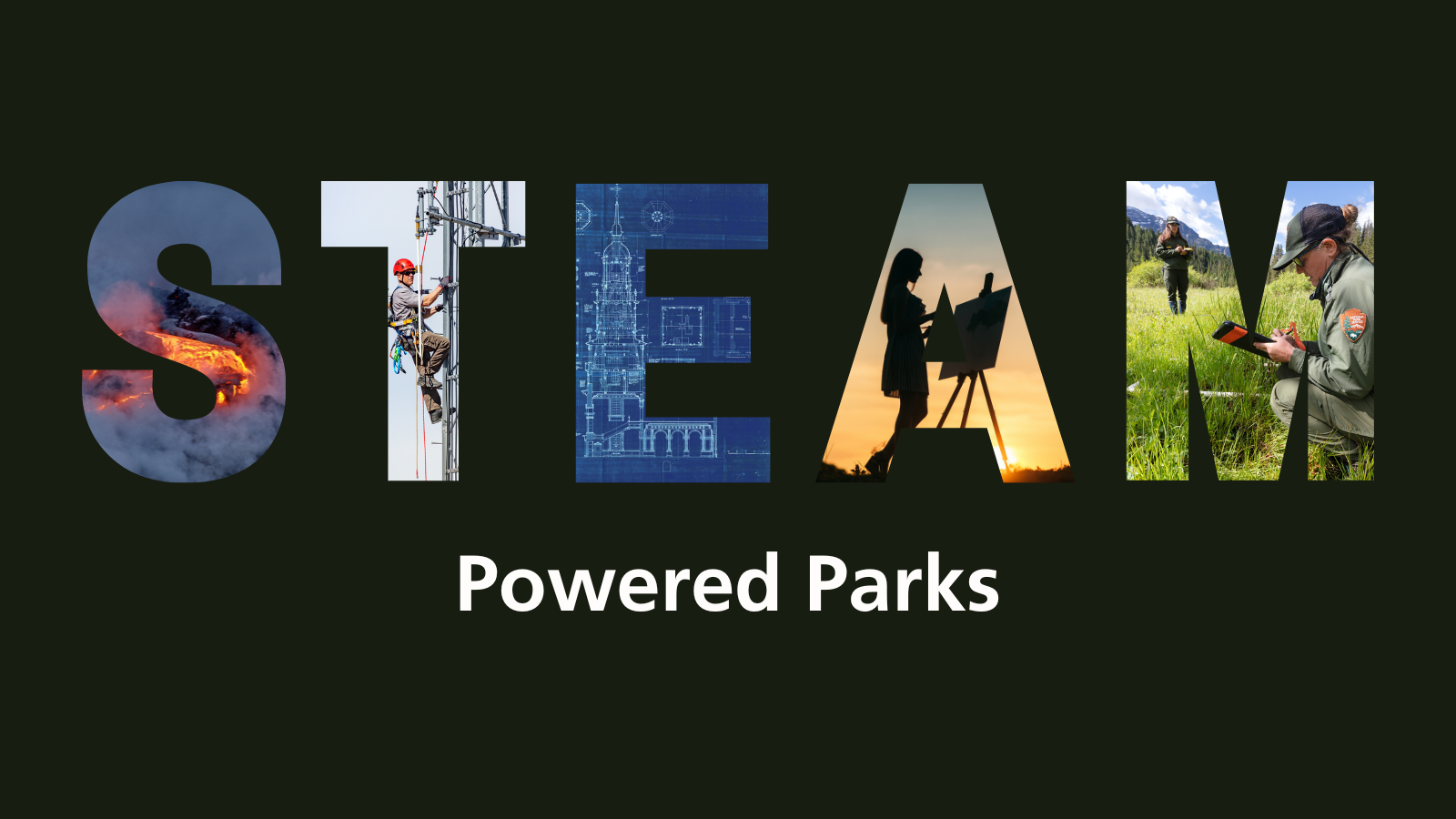Last updated: October 8, 2022
Article
Explore Your STEAM-Powered Parks

Graphic designed by the National Park Service
Science
National Park Service scientists, academic researchers, and volunteers are conducting groundbreaking scientific research every day. Whether studying wildlife, connected conservation, processes for preserving historic structures, the research in national parks and beyond our boundaries through our programs and partners, continues to push the bounds of understanding our world.
-
 JOIN INCitizen Science
JOIN INCitizen ScienceHelp with real scientific research! Citizen scientists are people just like you who volunteer to collect data for current research projects.
-
 STEAM Kids ChallengeJunior Explorers
STEAM Kids ChallengeJunior ExplorersHow many Junior Ranger patches can you earn while learning science? Explore caves, underwater, the night sky, and more!
-
 SCIENCE IN ACTIONPark Science Magazine
SCIENCE IN ACTIONPark Science MagazineCatch up on ongoing science research and topics in the National Park Service through our online magazine.
Technology
The history of the evolution of technology, and its complex and sometimes difficult effects—are preserved in many national parks. Visit the labs of innovative minds, including George Washington Carver and Thomas Edison, and other places were advances in technology were made. The National Park Service and our partners continue to look at ground-breaking technology to make it easier for people to experience their parks and natural and cultural resources across the country.
-
 TRENDING TECHThe NPS App
TRENDING TECHThe NPS AppThanks to technology, there is an app for everything including national parks! Download the free app to guide you through your visit.
-
 STEAM Kids Challenge#sciencedeskdigs
STEAM Kids Challenge#sciencedeskdigsExplore various items that can be found on a scientist's desk and learn how they are used in national parks.
-
 TECHNOLOGY IN ACTIONPreservation Technology Podcast
TECHNOLOGY IN ACTIONPreservation Technology PodcastThis podcast series explores how the National Park Service uses old and new technology to preserve the past for the future.
Engineering
National parks are home to many of the nation’s most iconic engineering marvels like the Golden Gate Bridge, Gateway Arch, Casa Grande, and Going-to-the-Sun Road. With more than 300 million visitors a year, engineers are essential to designing infrastructure so everyone can experience national parks. We continue to push modern engineering in the upkeep of these special places in parks, but also in communities through partnerships, grants, collaborating on research, and more!
-
 MEET OUR TEAMEngineers
MEET OUR TEAMEngineersMeet some of the many National Park Service staff involved in supporting engineering and learn about their projects.
-
 ENGINEERING IN ACTIONThe Great American Outdoors Act
ENGINEERING IN ACTIONThe Great American Outdoors ActThe law is promoting the improvement of infrastructure to increase opportunities for everyone to experience their national parks.
-
 STEAM Kids ChallengeDesign Your Own Parkitecture
STEAM Kids ChallengeDesign Your Own ParkitectureIf you created a national park, what would the architecture look like? Use your imagination to create your own unique PARK-itecture.
Arts
Art has been part of the history of national parks since the 1870s when Hudson River School painters captured majestic Western landscapes. Through their awe-inspiring works, a wider public came to see these special places in America for the first time. The works captured their imaginations, spurring them to preserve these lands for future generations. Today the tradition continues as parks are a place to practice the arts for expression, preserving heritage, capturing memories, and sharing the experience with others.
-
 FIND YOUR MUSECreate Art from Parks
FIND YOUR MUSECreate Art from ParksDancing, music, photography, drawing, poetry,.. Whatever your passion, find inspiration and even create art in national parks.
-
 STEAM Kids ChallengeSTEAM at Fairsted
STEAM Kids ChallengeSTEAM at FairstedHow many of these art projects fused with other STEAM fields can you create?
-
 ART IN ACTIONNational Fossil Day Art
ART IN ACTIONNational Fossil Day ArtThe annual contest encourages learning about prehistoric life through art and showcases incredible talent of artists of all ages.
Mathematics
Math is used daily in so many career fields throughout the National Park Service—budgeting, planning, maintenance, information technology... It is also at the heart of many large-scale projects throughout the national parks. For example, using geospatial imaging helps parks understand patterns in species population, make accurate maps of the lands, and develop models of the night sky and soundscapes throughout the year.
-
 DO THE MATHEducators Portal
DO THE MATHEducators PortalTeachers and parents can find activities that incorporate math with park topics to use in the classroom, at home, or in parks.
-
 STEAM Kids ChallengePredict Old Faithful
STEAM Kids ChallengePredict Old FaithfulMillions of people flock to Yellowstone National Park to watch this famous geyser erupt. Can you figure out its scheduled routine?
-
 MATH IN ACTIONMapping Sound
MATH IN ACTIONMapping SoundMath is part of the process for understanding soundscapes, which allows us to better preserve ecosystems and visitor experiences.
